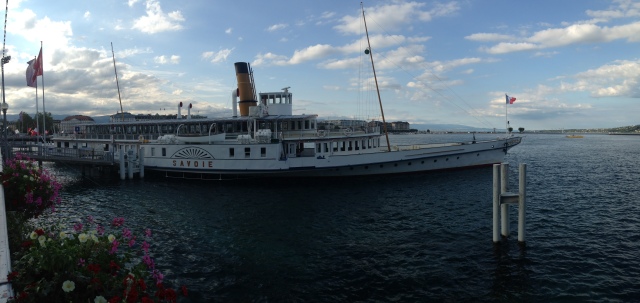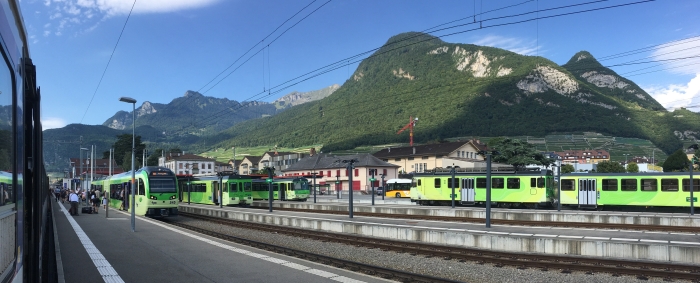A ticket from Zurich Burkliplatz (on the shore of Lake Zürich) to La Fouly (nestled high in the mountains of the Valais Canton) is exactly that. One ticket (not necessarily on paper these days) for a tram, four trains and one bus. With connections planned around a logical system timetable designed with the inter-modal passenger in mind the efficiency of the Swiss Travel System is supreme. When it comes to seamless public transport, the Swiss system remains exemplar. The contrast to the current situation in the U.K. could not be more acute.
Following my recent trip to the Swiss canton of the Valais, I couldn’t resist but to share a few snapshots of how just how seamless and wonderful Swiss transport really is. Pricy at times for the occasional user indeed. But anyone, Swiss resident or visitor is eligible to purchase a ‘Half Fare Card’ (CHF 185 for a year, reducing to CHF 165 in year 2) that cuts the cost of all travel, well, in half.

The idea of being able to get on a bus near my house in Lancaster and ask for a ticket through to Pentyrch, my family home village in South Wales (via 3 trains and another bus), have the driver click a few buttons on a touch screen ticket machine and accept the payment (by debit or credit card) seems like some sort of idealistic miracle. Throw in the idea of taking a push bike all the way with you on a spur of the moment basis and the whole scenario just becomes like something out of cloud-cuckoo land. Even if the Stagecoach bus driver on the service 18 ‘East City Circular’ in Lancaster happened to let the bike on ‘unofficially’ as the bus was empty, you’d be met by the Virgin Trains platform staff at Lancaster with ‘have you got a bike reservation’ (for the tiny compartment at the end of the train that takes a maximum of four bikes). In Switzerland, all of the idealistic (and more) is just part of every day life. As if by some sort of miracle, the ticket machine on every Swiss PostBus (station booking office and those carried by train guards) even in a remote Alpine valley can bring up the fare to any designated public transport stop in the country, be it a rail station, tram or bus stop, the top of a mountain funicular or cable car, even a boat pier on one of the picturesque Alpine Lakes… And as for the bike, that’s no problem too; just hook it on one of six bike racks on the rear of the bus (or in busy cycling valleys load it onto the bike trailer that the bus is towing capable of carrying somewhere in the region of the same number of bikes as seats on the bus!). Once at the railway station, a 3-carriage regional train has no problem holding at least 10 bikes. As for the mainline, pretty much every carriage on a 10-carriage InterRegio train along the Rhône valley line can take 6 bikes. It would take a mass gathering of cycling clubs to fill the one train alone with bikes.

The U.K. Department for Transport has been making lots of noise about ‘Smart Ticketing’ for what seems like over a decade now and still all we get is a handful of train and bus operators outside London offering some sort of smartcard or mobile ticketing that works for some fares, not others, rarely integrated across modes, overlain onto an archaic ticketing system that is so unbelievably complex that it’s no wonder that not even a computer model can decipher it. As for Anytime or Off-Peak Single fares only 10p or so less than a Return… on what planet has that ever been logical? It should have been abolished as soon as it came about (hopefully by mistake) but unfortunately it lingers on the 2017 U.K. railway.
Meanwhile in Switzerland, you fire up the SBB (Swiss Federal Railways) app, and within a matter of seconds of entering your start and end points for your journey and being shown the single fare (exactly half of the return fare of course), you can buy a single ticket for the whole journey via TouchID on your SmartPhone and have the ticket barcode happily sat in your ticket wallet app another few seconds later… in Switzerland the world literally is your Oyster.
What about traction? In absence of fancy names like ‘Azuma‘ being thrown in, Swiss rolling-stock generally has to settle for more functional nomenclature such as RABDe 500. However, one feature is ubiquitous; electric traction. Unlike in the UK, where mailine railway electrification remains a political football specifically in 2017, the Swiss set to work electrifying their railways from the early 1900’s. No diesel fumes wafting around stations, Swiss trains are emissions-free at the point of use with 99% of passenger trains being 100% electric. No faffing with bi-modes or waiting to see what opportunities hydrogen might provide in 20 years’ time. Even with it’s top-station at 3454 m, the Jungrfraubahn was built from the outset as a fully-electrified railway. What’s more, the coordinated national fleet strategy of the SBB has committed to a mass energy-efficiency drive with a committment to the fleet running on 100% renewable energy and avoiding nuclear. National and strategtic planning, a phrase that can rarely be used to describe transport infrastructure in the U.K.

The most exciting bit is when the system timetable throws up a journey with 6 changes and several modes. Fear not… this is nothing like what we’re used to at home, where the Arriva Trains Wales Service from Warrington Bank Quay, usually timed with a 6 minute connection from the southbound Virgin West Coast service, pulls out On Time and ahead of the latter, even if a short delay on the Virgin Train would only result in a knock on delay of 2 minutes or so. Net result; any connecting passengers are stranded for an hour on the platform. Not ideal if you’re heading for a ferry at Holyhead! By contrast, a 1 minute connection as advertised in the Swiss system timetable is one of their proudest achievements. You step off one train, and waiting patiently on the adjacent platform is your connection. No dashing up and down steps and half way across the station, just a leisurely stroll of a few metres whilst the elegant red-second hand of the iconic SBB CFF FFS station clock glides towards the top of the hour. But even in the land of the Cuckoo Clock things sometimes don’t go to plan. On the return trip of our recent visit, we were held up for 15 minutes (!) on a Transports de Martigny et Region SA bus feeding into a SBB RegionAlps train connection at the village of Orsières. Several hundred drenched runners taking part in one of the Ultra Tour du Mont Blanc races had lead to standstill on the road just a kilometre short of the interchange. The station staff were informed of the two feeder buses (one from Champex-Lac, the other from Val Ferret) being held up and to our relief, the train connection was held for 4 minutes to ensure around 20 passengers were on their way to Martigny and beyond without having to wait another hour.
The Swiss transport system is everything transport should be; clean, organised, simple, integrated… and so brings us to the end of this little story from the tiny picture postcard nation at the heart of Europe.
